
October 2003
Massacre Outside La Paz –
Discontent Among Troops – Workers Throughout the Country on Battle Footing
Bolivia
Aflame:
“Gas War” on the Altiplano
Workers to Power!
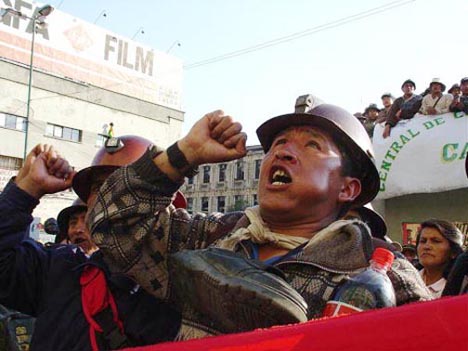
Bolivian miners demonstrating
in La Paz, October 17, cheered at reports
President Sánchez de Lozada had resigned. (Photo: Sebastian Hacher/Indymedia
Bolivia)
The Urgent Task: Forge a Bolshevik
Trotskyist Leadership!
The following article is translated from
a special October 14 supplement to El Internacionalista.
On October 17, amid an on-going general strike, a quarter million people,
including some 50,000 miners, mobilized in the Bolivian capital of La
Paz demanding the ouster of Bolivian president Gonzalo Sánchez
de Lozada. As the demonstrators were jammed in San Francisco square,
the president's resignation was announced. The downfall of the tyrant
will not free the Bolivian working people of their brutal exploitation.
The demand must remain: Workers to power! An update will follow.
OCTOBER 14 – For the last month, Bolivia has been shaken by massive mobilizations against the government of Gonzalo Sánchez de Lozada and his plans to export gas to an imperialist consortium. The confirmed death toll at the hands of the regime’s repressive forces is approaching a hundred, and over the last three days more than 60 have been killed. In the massacre carried out on Sunday, October 12 in El Alto – an impoverished city of some 600,000 strategically located at the entrance to the capital of La Paz, with a strong presence of Aymara Indians among its residents – more than 30 civilians were killed. It is now being reported that 15 conscript soldiers were shot by their officers execution-style for refusing to fire on the people. In Bolivia’s “gas war,” anger is rising as workers’ and peasants’ blood flows on the altiplano (high plateau). Today, columns of workers were descending the slopes which surround the capital, carrying the caskets of their murdered comrades and shouting the slogan, “Workers to power!”
The puppet president, imposed by the U.S. embassy although he received barely 22 percent of the vote, rails against the “danger” of a “union dictatorship,” just as in the past the rulers screamed about the “communist threat.” Yet while this is at bottom a battle between the classes, the leaders of the peasant, Indian and union organizations distort this reality with narrow nationalist rhetoric. They denounce Chile and Peru, as if they wanted to re-ignite the War of the Pacific (1879-1883). No! The struggle must be directed against Yankee imperialism – and its local bourgeois lackeys – which after invading Afghanistan and Iraq is now trying to impose colonial subjugation on these countries. It is clear to all that a decisive clash is coming, and in that hard fight against a powerful enemy, what’s needed is unity with the Chilean, Peruvian and North American working people.
Bolivian workers have once again demonstrated
the heroism that has characterized so many moments of their history. But
despite their enormous militancy, the key element is still missing: a revolutionary
internationalist leadership with the class program and determination needed
not only to overthrow the hated “Goni” (Sánchez de Lozada) but
to sweep away the entire bourgeoisie and its repressive apparatus, through
socialist revolution that spreads internationally. The task of the hour
is to fight all those forces which try to divert this struggle in a “democratizing”
direction, into nationalism and class collaboration. It is urgently
necessary to show a revolutionary class road: through elected strike committees,
made up of delegates who can be recalled by the ranks at any moment, as
well as workers self-defense committees and groups. Neither Vice President
Carlos Mesa nor any kind of bourgeois “constituent assembly” are what’s
called for, but rather revolutionary workers, peasants and soldiers councils
along the road to a workers, peasants and Indians government. It is necessary
to give flesh and blood to the slogan, “Workers to power.” In order to do
so, what’s required is to form the nucleus of a genuinely revolutionary
party, a Bolshevik-Trotskyist party.
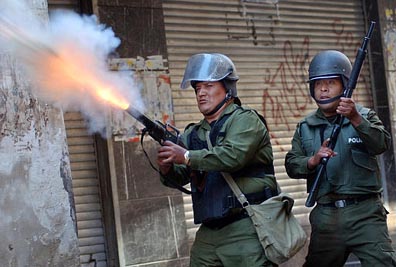 Police fire on demonstrators
in La Paz, October 16. (Photo: Rodrigo Abd/AP)
Police fire on demonstrators
in La Paz, October 16. (Photo: Rodrigo Abd/AP)
For several years now there have been repeated struggles in Bolivia over “globalization” and “neo-liberalism.” In April 2000 there was the “water war” in Cochabamba against privatization of the life-sustaining liquid by the Aguas del Tunari company, controlled by the U.S. “multinational” corporation Bechtel. On that occasion, six people were killed, and even though the dictator Hugo Bánzer decreed a state of siege, the struggle culminated in the takeover of the city by its inhabitants and cancellation of the contract. Despite its defeat in the “water war,” Bechtel, one of the richest companies in the world, sued Bolivia, one of the poorest countries in the world, for US$25 million in the California courts. Now it’s back on the attack with the “gas war.” The Pacific LNG consortium which is organizing the mega-project to export Bolivian gas (valued at US$7 billion) is composed of Bechtel, Amoco, British Petroleum and Repsol-YPF – U.S., British and Spanish companies, that is, from the same imperialist powers that just invaded Iraq. The gas is intended to resolve the electricity crisis in California, whose new “governator” Arnold Schwarzenegger is reputed to be tied to the energy cartel.
From the time of the “Rosca” (ring), the narrow clique of tin barons who dominated Bolivia up to the 1950s, to the “revolutionary” nationalist regime of Víctor Paz Estenssoro, who began the first of three presidential terms in 1952, to the series of military dictators of the ’70s and ’80s and the “negotiated democracy” of the ’90s, the bourgeoisie has maintained the yoke of capitalist exploitation. The particular individuals and political regime of the moment are secondary matters. It’s not just a question of a neo-liberal “model” or a globalized economy. The Bolivian masses are suffering under the yoke of capitalism and imperialism, and the solution cannot be limited to canceling a contract or the fall of the current president: what is necessary is workers revolution.
During his first presidential term, from 1993 to 1997, Sánchez de Lozada carried out to the letter the privatization plan which he began in 1985 as planning minister during the third presidency of Paz Estenssoro, his fellow leader of the Revolutionary Nationalist Movement (MNR), when they stripped the Bolivian Mining Corporation (Comibol) of its assets by means of the notorious Decree 21060. With the “decentralization” of Comibol, which they could only ram through under a state of siege, they dismantled the state-owned mines and destroyed the strongest sector of the proletariat, under the disguise of “relocating” the miners. This and the subsequent “capitalization” (i.e., sale to imperialist investors) of several public companies gave “Goni” and his pals of the new Rosca the opportunity to enrich themselves through large-scale looting of state properties. When, on top of all this, he tried to raise income taxes at the beginning of 2003, affecting his own base in the middle class, it was the last straw. There was an explosion of popular anger against the “impuestazo” (tax attack).
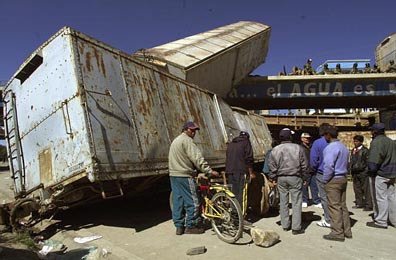
The blow-up began on February 12 with a mutiny by police upset over the absence of a pay increase in the new budget. Virtually the entire Bolivian left solidarized with the cops, even shouting “long live the uprising of the workers in uniform,” as did a leaflet by Guillermo Lora’s Partido Obrero Revolucionario (POR – Revolutionary Workers Party). Others, like the small Liga Obrera Revolucionaria por la Cuarta Internacional (LOR-CI, Revolutionary Workers League for the Fourth International), more timidly raised the call for “a policy that would make support for the mutiny conditional,” at the same time as it declared February 12 and 13 to be “revolutionary days” (Lucha Obrera, March 2003). This despite the fact that the working class was only weakly mobilized, and that only on the second day. Notwithstanding the support from the left, whether enthusiastic or conditional, the “days” ended after a day and a half when a 40 percent raise was granted to the police. These professionals in anti-working-class repression were soon back on the job, beating looters and workers alike. It was correct to seek to make use of the breach opened up by the crisis in the armed institutions of the bourgeoisie, but genuine Trotskyists give no support to the action of the police and do not prettify as “revolutionary” what was a mutiny with Bonapartist overtones.
Forced to backtrack on the “tax attack,” Sánchez de Lozada returned to the charge with the project for selling off Bolivia’s gas. This provoked a “civic work stoppage” in El Alto on September 15, followed by a national day of mobilization on the 19th, and the call for an unlimited general strike by the Central Obrera Boliviana (COB – Bolivian Labor Federation) along with highway blockades by peasant organizations. However, the COB under miners’ leader Jaime Solares, did not build the strike heavily outside of the capital, the teachers in La Paz decided to go back to their classes after only two days, the road blockades were limited to the altiplano north of La Paz, dominated by the wing of the peasant union (CSUTCB) led by Felipe Quispe (the “Mallku”), who agreed to “dialogue” with the government, and Evo Morales, head of the Movement for Socialism (MAS) and leader of the coca-growing peasants of the Chapare region, was out of the country trying to duck the issue. Thus the action was limited to middle-class sectors and undercut by feuding among the bureaucratic leaders. But then another blow landed.
The government, in the person of the arrogant defense minister Carlos Sánchez Bersaín, on orders from the haughty American proconsul David Greenlee (former head agent of the CIA in Bolivia during the 1980s), decided to attack the region of Sorata and Warisata, in order to “rescue” tourists who had arrived in the area near Lake Titicaca. This area was a “sanctuary of Indian education,” where in 1937 the famous Warisata Ayllu School was founded, one of the first rural pedagogical institutes in Latin America to train teachers for bilingual education. The attack was not accidental. President Sánchez de Lozada himself subsequently said that they “study something else and not to become teachers,” while the government minister (in charge of police), Yerko Kukoc, alleged that the professors are “people with radical ideas” who are providing a “very radicalized education” (Pulso, 10 October).
According to an account we have received from
La Paz:
“It’s known that after some ten days in which those tourists were stuck in the region due to the road blockades, the population was furious at the government over its failure to resolve the demands raised. The [defense] minister’s arrival in the area provoked a reaction which in reality was intended to reproach him for his delay. In the face of the crowd, the minister fled back to the city in his helicopter. It was from here that he ordered the organizing of a military caravan to accompany the buses carrying the tourists and others. Before arriving at Warisata, the army tried to clear the road blocked by the peasants and began shooting with impunity. Seven people died, among them an eight-year-old girl. That was the spark.”
The media transmitted the photo of an Aymara Indian mother, carrying her wawa (child) on her back, with an antiquated Mauser rifle from the time of the Chaco War (in the 1930s) to defend herself from the troops.
The Massacre of El Alto
This government provocation was followed by another one, the election of the “people’s defender” (a kind of ombudsman empowered to investigate human rights cases), when the parliament imposed the candidate picked by the president. Meanwhile, an indefinite work stoppage was decreed in El Alto beginning October 8 (the anniversary of “Che” Guevara’s assassination by the Bolivian army and the CIA in 1967), which had the effect of blocking supplies from reaching La Paz. Although it was called by the Federation of Neighborhood Committees (FEJUVE), it was dominated by El Alto’s combative Regional Labor Confederation (COR) with heavy participation of students from the Public University of El Alto (UPEA). The next day, Thursday October 9, a contingent of hundreds of mine workers from Huanuni arrived at Ventilla, a district in El Alto, to support the struggle. Then the serial massacre began. The military fired their weapons, killing the miner José Luis Atahuichi Ramos and the worker-student Ramiro Vargas Astilla. There followed clashes in several of the districts in El Alto, including Río Seco, Villa Adela, Tunari, Alto Lima and above all Santiago II, where many laid-off (“relocated”) miners live. But the trucks were unable to get past the pickets.
The Massacre of El Alto reached its high point on Sunday the 12th, when the government tried to break the blockade around the capital. Beginning in the early morning hours, the army undertook an operation to transport 12 tank trucks from the storage plant at Senkata. The account from La Paz continues:
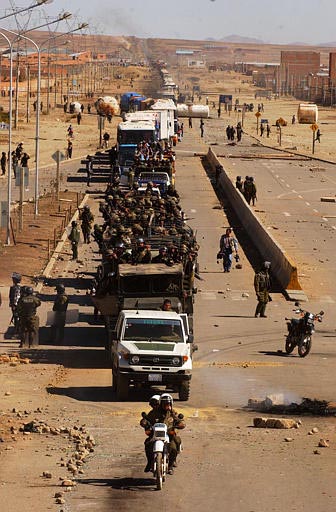
(Photo: Dado Galdierei/AP)
From the Senkata plant to the center of La Paz
is a distance of about 20 kilometers. That day some 31 civilians were
murdered by the “forces of order,” more than one per kilometer. With 95
wounded, the hospitals of El Alto were overflowing. Such is the price in
human lives this vampire government is willing to charge in order to keep
afloat in the “gas war.”
“So far, 57 have died from gunshots. From Sunday on, the movement has continued to move down the hillsides into the city of La Paz. The mobilization has extended to the rest of the country. Two dead in Santa Cruz. Two dead in Cochabamba. General strike in Sucre, the same in Potosí. The Huanuni miners have decided to seize the mines owned by Sánchez de Lozada. The university students are mobilized.
“On Monday night, Sánchez de Lozada issued a decree announcing that the decision on the gas exports would be made in December, after consulting the people. It was another slap in the face. After so many deaths, people expected that at least the defense minister would resign, together with the head of the cabinet (minister of government), or that the city would be demilitarized. Nothing of the sort. Immediately, at an early hour, the vice president gave a press conference. He announced that he was distancing himself from Sánchez de Lozada, without resigning the vice-presidency.”
The ministers from the New Republican Force (NFR), a right-wing populist party, announced their withdrawal from the cabinet. However, the U.S. embassy put out a communiqué supporting Sánchez de Lozada. Jaime Paz Zamora of the “Revolutionary Left Movement” (MIR) immediately announced his support for the president, and was soon followed by Manfred Reyes Villa of the NFR. In a sign of the mass fury, Paz Zamora’s home was set on fire, as was the NFR party headquarters. “Everything indicates that the U.S. policy is in full swing: harden things up, and kill.”
The Fight for a Bolshevik Trotskyist Party in Bolivia
In earlier confrontations, both in April 2000 and in February of this year, the opposition to the government was dominated by outfits of a popular-frontist character. They embodied or sought a class-collaborationist alliance with bourgeois sectors – a “popular front” such as in France or during the Spanish Civil War in the 1930s, or Salvador Allende’s Unidad Popular in Chile at the beginning of the 1970s. (In 2000, it was the Cochabamba Water Coordinating Committee, in February there was the People’s Command.) Currently, the pro-capitalist union tops and petty-bourgeois peasant leaders do not have solid control of the conflict, which is increasingly dominated by open combat between the working class and the capitalist class. “Workers to power!” chant the working people of El Alto as they carry the caskets of their martyrs. They are taking up the slogan that 12,000 miners raised two decades ago when they occupied La Paz against the popular front government of Hernán Siles Zuazo, whose attacks on the mining proletariat set the stage for the infamous Decree 21060.
Faced with the danger that the crisis could get out of hand, the union misleaders are anxiously seeking a deal with imperialism. Up until a couple of days ago, they only asked that Sánchez de Lozada cancel the gas sale. After last weekend’s massacre, this is no longer enough to calm the masses. So Evo Morales of the MAS is now calling for the president to resign and for vice president Carlos Mesa to take the reins of power, and that a “constituent assembly” be called to “refound the country.” This demand was also raised a year ago by a popular-front political lash-up in opposition to the Free Trade Area of the Americas (FTAA, or ALCA in Spanish) including the MIR, the NFR, the Socialist Party and the Pachakuti Indigenous Movement led by Felipe Quispe. At the same time, the call for a constituent assembly (dressed up with the adjective “revolutionary”) is the axis of the political platform of the LOR-CI, who inherited it from Nahuel Moreno, the Argentine pseudo-Trotskyist who died in 1987. In the mouths of bourgeois and petty-bourgeois politicians, this slogan is a means of preventing the struggle from escaping the bounds of capitalist “democracy”; coming from leftist groups, it is a policy intended to evade the need to really fight for workers revolution, a kind of “minimum program.”
In the current Bolivian context, where the threadbare bourgeois “democracy” typical of semicolonial countries already exists, with its spider’s web of electoral fraud, the demand for a constituent assembly (whether or not it is dubbed “revolutionary”) has nothing revolutionary about it. This democratizing slogan dissolves the proletariat into the “citizenry,” diluting the class struggle into a “democratic” soup, and points to an electoralist “way out” of the crisis. It is not for this that so many have given their lives. For its part, Guillermo Lora’s POR is calling for a new version of the Asamblea Popular (People’s Assembly) of 1971, a body which was not formed by electing delegates who could be recalled by the worker and peasant ranks, but rather by deals between the reformist and bourgeois leaders. In reality, it served to tie the working people to the bourgeois government of General Juan José Torres. It is no accident that the Asamblea Popular of 1971 did nothing to prepare the masses to resist the bloody “coup foretold” of General Hugo Bánzer, nor that the assembly’s “continuation” (as Lora always calls it), the “Anti-Imperialist Revolutionary Front” (FRA), was a class-collaborationist popular front with Torres, sectors of the MNR and other bourgeois elements.
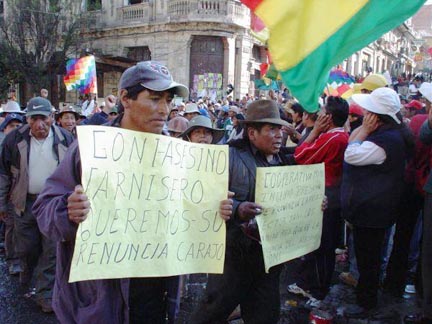 Miners demonstrate
in La Paz October 17. Sign on left says: “Goni, You Bloody
Butcher, We Want Your Resignation, Damn It!”
(Photo: Sebastian Hacher/Indymedia Bolivia)
Miners demonstrate
in La Paz October 17. Sign on left says: “Goni, You Bloody
Butcher, We Want Your Resignation, Damn It!”
(Photo: Sebastian Hacher/Indymedia Bolivia)
The central demands of a revolutionary vanguard
in Bolivia today must point the way to root out all capitalist exploitation
and oppression through a proletarian revolution that establishes a workers
and peasants government. Among the radicalized rank and file, some are
already talking of the need to take power. The League for the Fourth International
calls to form strike committees, with elected delegates,
recallable at any time; for factory, mine and plant committees;
and for expanding these bodies into workers, peasants and soldiers
councils, like the “soviets” during the Russian Revolutions of
1905 and 1917. Instead of the fraudulent electoral “representative democracy”
of the bourgeois state, these committees will serve as organs of direct
workers democracy to organize the revolutionary struggle, and later they
can lay the basis for a workers state. Instead of distorting and putting
obstacles in the way of the working masses with the bourgeois electoral
machinery, which allows the “electorate” to periodically vote on who will
exploit them for the following period, soviet democracy serves as a transmission
belt permitting the combative will of the masses to express itself, overcoming
the bureaucratic impediments in the unions.
The miners’ dynamite is a symbol of their militancy, and has been a rather effective means of blocking roads. Yet it is far from sufficient to defend the masses against the white terror unleashed by the bourgeois government. It is necessary to form workers defense groups and committees, pointing toward the formation of workers and peasants militias. Beginning from a proletarian nucleus, these can bring in peasants and the growing number of soldiers who want to “turn their cap around” and join the workers in revolt. All this must lead to a struggle for a worker-peasant-Indian government, the dictatorship of the proletariat which would overthrow the bloody dictatorship of capital and open the way for the real liberation of the oppressed masses by expropriating the bourgeoisie, passing over from democratic tasks to socialist tasks. The struggle for workers revolution against imperialism and the “national” bourgeoisie must be international, extending throughout the region in an Andean federation of workers republics and a Socialist United States of Latin America. In all of this, the essential element is to forge a Trotskyist Bolshevik party.
A genuine Trotskyist party would combat the bourgeois nationalist poison that counterposes the Bolivian working people to their Chilean and Peruvian class brothers and sisters. Trotskyist internationalism is the opposite of the old nationalist verbiage of Lora’s POR about reclaiming the “outlet to the sea,” and the silence of groups which don’t even mention the anti-Chilean attacks of the leaders. A policy of proletarian internationalism must be made concrete in action. Currently, a real vanguard party in Bolivia would fight to join forces with the Chilean workers, who just carried out their first general strike in many years; with the Peruvian workers who waged a hard-fought teachers strike against the Toledo government; and with the workers and indigenous peoples of Ecuador in the face of the attacks of the former coup-plotting colonel, now president, Lucio Gutiérrez, who was elected with the votes of the left (see our pamphlet, Ecuador: Hervidero al borde del estallido [Ecuador: Cauldron at the Boiling Point], July 2003, which is also available on the Internet).
Beyond South America, the fate of the Bolivian working people is intimately bound up with the class struggle on a world scale. In order to strike a blow at the imperialist masters, it is vital to fight for the defeat of the colonial occupation of Iraq and Afghanistan. It is necessary to defend Cuba against imperialism and internal counterrevolution. At the same time, workers in the United States and throughout the world must express proletarian solidarity with the Bolivian masses concretely, blocking the transport of arms to the murderous regime by “hot-cargoing” (stopping the shipment of this matériel).
Gonzalo Sánchez de Lozada has bragged on a number of occasions that he will only be dragged out of the presidential palace dead. Up to now, he enjoys the unrestricted support of his bosses in the White House, expressed in a statement to the OAS (Organization of American States) by Bush’s national security advisor Condoleezza Rice. But Yankee imperialism is not exactly loyal to its semicolonial satraps and viceroys when they become inconvenient; just consider the fate of Rafael Trujillo in the Dominican Republic (1961), Ngo Dinh Diem in South Vietnam (1963), and Manuel Noriega in Panama (1990). Notwithstanding “Condi’s” praises, “Goni” could well end up like late 1940s president Gualberto Villarroel, hung from a lamppost. But for the working class, it is not sufficient to topple the tyrant of the day, it’s necessary bring down the whole system of ferocious exploitation which has subjected the country of the altiplano to centuries of desperate poverty.
Bolivia has been looted since the times of the
mita (the forced labor system, taken over by the Spanish colonizers from
the Incas), when streams of silver flowed out of the Cerro Rico of Potosí
at a cost of unspeakable suffering by the indigenous miners, to be minted
into coins by black slaves and provide much of the currency of the Spanish
realm. The lords of silver were followed by the tin barons, but the “National
Revolution” of 1952, dominated by the bourgeois MNR of Paz Estenssoro
and Siles Zuazo, did not destroy, nor could it destroy, the imperialist
yoke, because it did not go beyond the bounds of capitalism. The same
MNR which was forced to nationalize the mines in 1952 closed most of them
in 1985. Today it is represented by the most egregious puppet of Yankee
imperialism, the hated “Goni.” Yet the opportunist left wants to keep on
binding the masses to the framework of bourgeois nationalism. Imperialism
will never pull its bloody claws out of the living body of Bolivia and
all of Latin America without a proletarian revolution that spreads internationally,
above all to the multi-racial and multi-national working class of the United
States, thereby destroying the imperialist monster once and for all.
At this moment, when the valiant Bolivian workers are confronting the repressive onslaught of the lackeys of imperialism, the League for the Fourth International calls:Undertaking the building of an authentic Trotskyist party in Bolivia, as an integral part of the struggle to reforge the Fourth International, is the task of the hour!
- Form strike committees – with elected and recallable delegates – and factory, mine and plant committees! Fight to expand these committees into workers, peasants and solders councils!
- For the formation of workers defense groups and committee, pointing toward workers and peasants militias!
- The working class should seize the oil, mining and gas facilities, imposing their expropriation without compensation and workers control by the ranks of production and distribution!
- Fight for a worker-peasant-Indian government, for workers revolution that will expropriate the bourgeoisie, extending to an Andean federation of workers republics and a Socialist United States of Latin America!
- For international working-class solidarity with the Bolivian masses – “Hot-cargo” arms shipments to the murderous regime!
- U.S. troops and agents out of Bolivia! For the defeat of the colonial occupation of Iraq and Afghanistan!
- For the unity of Latin American and North American working people! Sweep away imperialism through international socialist revolution!
|
Fists of Anger Are Raised:
“¡Goni Asesino!”
(Gustavo Sánchez de Lozada Is A Murderer) We print below excerpts
from e-mail messages, written at different times on October 14, which
have reached us from the Bolivian capital, La Paz.
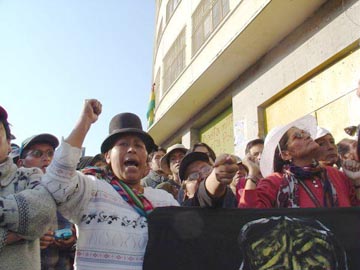
Women protesters
in La Paz, October 17. (Photo: Sebastian Hacher/Indymedia Bolivia)
We
print below excerpts from e-mail messages, written at different times on
October 14, sent to us from the Bolivian capital, La Paz.The factor generalizing the conflict – which we were not able to find for 15 years – has been given to us by the government itself: Sánchez de Lozada must go! One gets the feeling that history took this necessary turn to avenge itself. Last night hundreds of mine workers arrived in the city. Together with them, the gremialistas (street and market vendors, who are organized in unions) have taken to the streets. Southern La Paz is also mobilized: from the hillsides where the domestic employees live, the dairy maids, the carpenters, the mechanics…. Right now a march of mourners, carrying Bolivian flags with black ribbons, with wiphalas (the multi-colored flag of the indigenous movement), yelling with rage, is coming down from El Alto along United Nations Avenue. The number of dead is 43 now, and I do not want to keep counting. I feel that contradictory emotion, of admiration and pain, which the strength of the people, and their dead, causes in me. Mass meetings are being held in the neighborhoods. The radio is broadcasting a huge meeting in the San Miguel church, where even the proper residents of that [well-to-do] area are calling the peasants brothers who are arriving there from Ovejuyo, Chasqui Pampa and the area of the Illimani valleys…. The process evolved toward becoming politicized in an exceptional manner. At this moment, the indigenous and peasant movement is almost secondary. By moving to the cities, it met up with the poor neighborhoods where the unemployed live. Obviously, these sectors are more politically aware. To this must be added the historic heroism of the people of La Paz, whose memories have accumulated so many insurrections. The movement is spontaneous. It is being led intuitively by the neighborhood leaders. Their objective: the head of Sánchez de Lozada. It doesn’t go beyond that…. The forces have built up over these 15 years. In February, a spark was lit, but it was still a lumpenproletarian spark, with confusion thrown in by the police mutineers, not to be trusted. Today things have changed. The spark is political, though still with all the inconsistencies which are part of the movement, with its ambiguities and lack of precision. I don’t think this is the preamble to the seizure of power, because there is no political leadership which goes beyond ousting the current government. A final showdown is still pending. I fear that Sánchez de Lozada has made some private deals that he has to attend to, and for that reason he holds onto power in such an obsessive way, pressured by the multinationals and the U.S. embassy…. A silence of the grave has settled over the city of La Paz. The moral condemnation to which it bears witness has the government bottled up in the presidential residence of San Jorge. Sporadically, church bells peal, the sound mixing with that of a stick of dynamite going off on the hillsides. The funerals have begun. Women dressed in black, their heads covered with heavy cloth, are groaning. “Who is going to help me? What’s to become of my wawas (kids)?” And the caskets keep coming. People are stunned, filled with pain and anger. “¡Goni asesino!” (Sánchez de Lozada is a murderer). The fists of outrage are raised. Dozens of Indian youths have been killed. The wakes are held on the ground itself, in the midst of the poverty that permeates each and every day. A few small candles accompany the bloodied bodies. The paving stones have been dug up from the streets to form barricades. We are all waiting to hear Sánchez de Lozada’s last word. Until that time the waiting will be filled with tension. |
Versión en español: Arde Bolivia: La guerra del gas
To contact the Internationalist Group and the League for the Fourth International, send e-mail to: internationalistgroup@msn.com